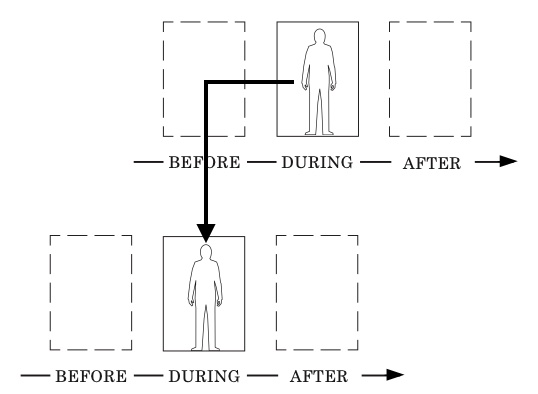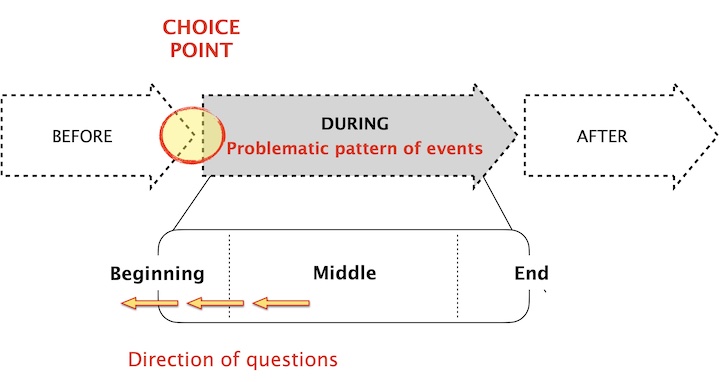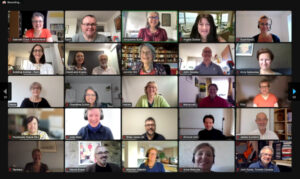Inviting a client to ‘move time back’ using Clean Language is a fundamental feature of Symbolic Modelling and there are more ways to do it than you might realise.
When we tell our stories and explain our experiences we tend to describe events in a progressive sequence one after another: ‘This happened, then this, then this …’. For convenience I’ll refer to this sequence as, ‘in a forward direction’ (as in this case, almost all our language about time involves spatial metaphors).
To counter this natural forward direction, a facilitator’s questions need to invite the client’s attention to move back in their subjective perception of events. David Grove emphasised that unlike moving-time-forward questions, shifting attention back takes effort. He used to say the delivery of this type of question needs to “pull back” time.
The process of pulling time back is independent of the common past-present-future timeframes. It’s about inviting the client’s attention to shift ‘back’ to a prior event or an earlier time relative to a temporal marker specified by the client. Thus ‘back’ could be in the client’s past, or remain in their present, or it may be an event that has yet to happen in their future!
In the land of metaphor, rather than past-present-future, more generic and more useful timeframes are before-during-after. Figure 1 shows how Penny and I depicted pulling back time in Metaphors in Mind (p. 75):

In Figure 1, the ‘before’ event or moment becomes the centre of attention and the current ‘during’ is straddled by another relative ‘before’ and ‘after’.
Clean facilitation
Penny Tompkins and I have noticed that inviting the client to move back in time is often an underused feature. And this is regrettable because clients often discover things going back in time that are not available to them while going forward.
To demonstrate just how often this feature could be used, we recently gave a supervision group a coaching transcript and asked them to identify where it could be valuable to invite the client’s attention to move back in time. They were then asked to devise an appropriate a question for each place they’d chosen, and finally to specify their purpose for asking it.
Questions
The group came up with nine Clean Language question formats that would invite the client to attend to an earlier time or earlier in a sequence. I have listed the generalised format of these questions below.
The italics indicate the part of the question that presupposes an earlier timeframe.
Classic clean questions:
- And what happens just before [event] ?
And where does/could … come from ?
A common contextually clean question:
And is there anything (else) that needs to happen for [desired Outcome or necessary condition]?
Other contextually dependent questions:
- And what happened when [prior time]?
- And what was happening to [symbol] before [event]?
- And what kind of [symbol] was that [symbol] before it was [attribute]?
- And what’s the first … ? (When a number of events has been mentioned)
- And how old could … be? (When used within a ‘child-within’ framework)
- And what happened between X and Y ? (Where ‘Y’ is the current or a previous timeframe)
Purpose
There are many reasons why inviting a client to move back in time is valuable. Here are just a few:
To identify a:
- Prior event
- ‘Choice point’ in a habit
- Source or origin (of a resource or a problem)
- Cause (e.g. of a Problem)
- Necessary condition for a desired outcome to happen
- Contingent event/factor
- Prior occurrence in a series
Function
In Metaphors in Mind we described the function of three ‘moving time back’ questions:
1. And what happens just before X?
Asks the client to notice what occurs during the preceding event. The word ‘just’ plays an important role by directing the client’s attention to the moment immediately before the one they have just described. It’s like winding back a video recorder just one frame … When asked repeatedly [this question] winds back a client’s perception frame by frame to the beginning of a sequence, or even to the moment before the sequence starts. (pp. 75-76)
While a beginning-middle-end format is classic story-telling, my experience is that client’s rarely start at the beginning; they usually start telling their story somewhere in the middle. Therefore, a client’s attention will need to go back in time in order for them to attend to the beginning of a sequence or pattern.
Repeated use of the ‘And what happens just before [event]?’ question will usually facilitate a client to identify the vital threshold between the previous state/pattern and the very start of the state/pattern under discussion. This process is the basis of our choice point model (see Figure 2).

If you are facilitating a client to self-model a problematic sequence, keep pulling back time until it is clear a prior and usually very different (more resourceful) state is reached. Then, by toggling forward and back in small increments the client will come to better know what happens at this threshold. When crossing the threshold happens very quickly, toggling will ‘stretch time’ allowing ‘a split second’ to be examined for 5, 10 or 15 minutes.
You can see an example of how pulling time back to before the beginning of a problematic pattern can facilitate the client to locate a prior resourceful time in Resources, embodied metaphor and Clean Language.
2. And where does/could X come from?
Clients generally give this question one of four meanings (Metaphors in Mind, pp. 76-77):
- What made ‘X’ possible or caused ‘X’ to happen?
- What was the location of ‘X’ before its present location?
- What or who had ‘X’ before
What is the source/origin of ‘X’?
For example:
C13: It looks like twisted pasta. It’s big. It’s old. It’s dull. It’s metal, iron, black.
T13: And … where could that old iron come from?
C14: A spear.
We assume that the client opts for the last [of the four] meanings and that her attention has moved to the source of the old iron – a spear before it was a door handle. Had the client given this question a different meaning she might have replied:
“A forge” What made “old iron” possible. “Underground” Location of “old iron” before it was on castle door. “My father” Who had “old iron” previously.
An extended example of moving time back can be found in the Lozenge transcript in Metaphors in Mind (pp. 273-281). See also David Grove’s Intergenerational Healing (Quadrant IV) process.
3. And is there anything (else) that needs to happen for [desired Outcome or necessary condition]?
By repeatedly inviting the client to discover what needs to happen for a change to take place in their metaphor landscape, you encourage them to find the logical associations between the first thing that needs to happen and all the subsequent things that need to happen for a desired change to occur. In this way a symbol’s function can be enacted or its intention satisfied, and this inevitably influences other parts of the landscape. (Metaphors in Mind, p. 179)
Examples of variations on this question can be seen in pages 201-203 of Metaphors in Mind. There is also a discussion of the function of this question in ’Stage 4’ of our 2010 coaching process, A Clean Framework for Change, and in the section ‘Necessary conditions’ in Context Makes Clean Clean.
To summarise
Inviting a client to move time back using Clean Language is a fundamental feature of Symbolic Modelling. Grove said that “pulling back” time is needed to counter the natural forward motif of clients’ story-and-explanation telling. I’ve listed several clean questions that can be used to do this.
Clients can have experiences going back in time that are not available to them while their attention is going forward. Hopefully this blog will encourage more facilitators to skilfully use this feature in service of their client’s self-modelling.








